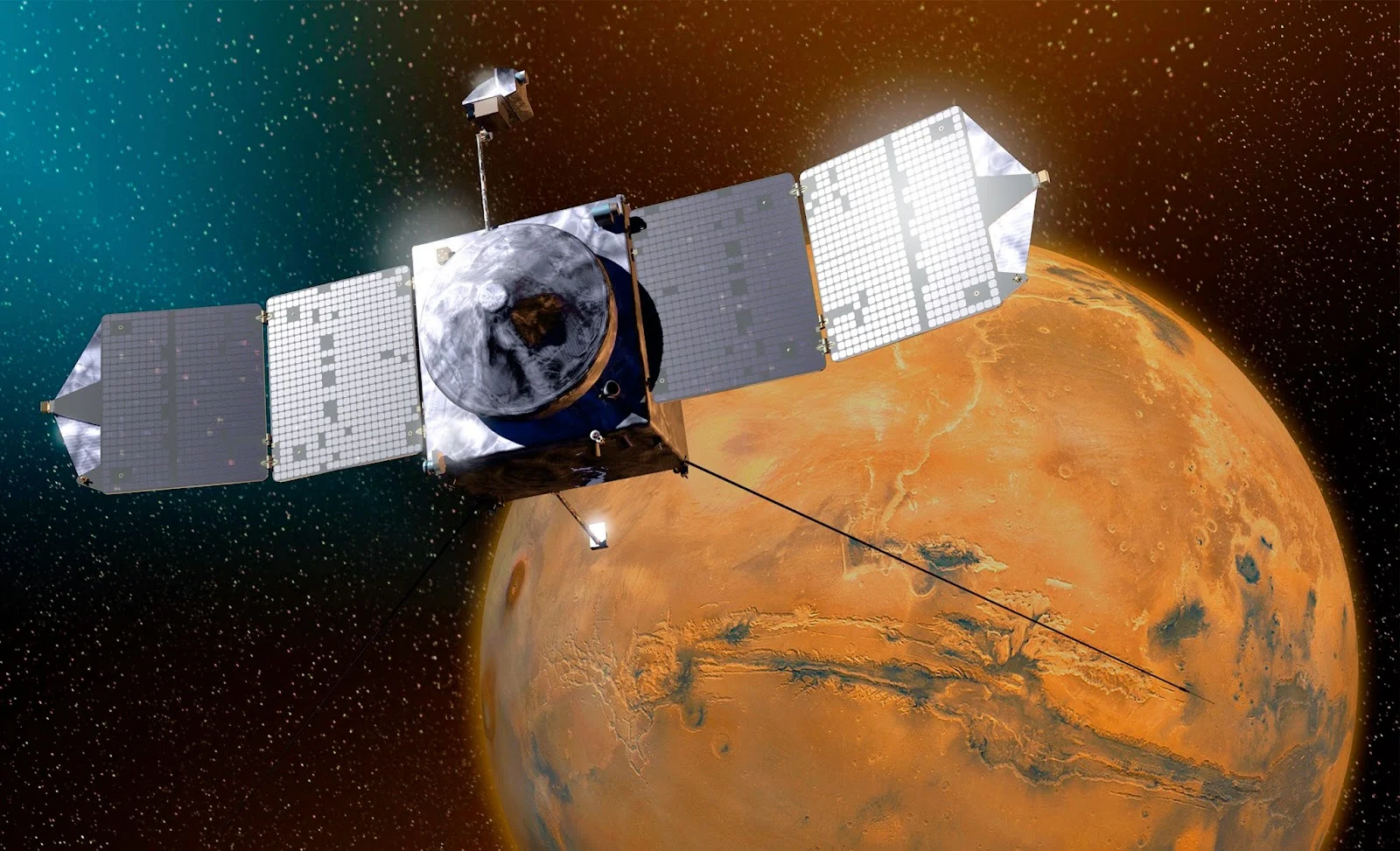A NASA spacecraft designed to investigate how Mars lost its water is expected to put itself into orbit around the Red Planet today after a 10-month journey....
After traveling 711 million km from Earth, the Mars Atmosphere and Volatile Evolution, or MAVEN, probe faces a do-or-die burn of its six braking rockets beginning.
If successful, the thruster burns will trim enough speed for MAVEN to be captured by Mars' gravity and fall into a looping orbit.
Over the next six weeks, as engineers check MAVEN's nine science instruments, the spacecraft will maneuver itself into an operational orbit that comes as close as 150 km and as far away as 6,200 km from Mars' surface.
MAVEN, said Jakosky, will tell them "the boundary conditions that surround the potential for life."
MAVEN will join a fleet of two US orbiters, two US rovers and a European orbiter currently working at Mars. India's first Mars probe is due to arrive on Wednesday.
buenosairesherald.com
21/9/14
--
-
After traveling 711 million km from Earth, the Mars Atmosphere and Volatile Evolution, or MAVEN, probe faces a do-or-die burn of its six braking rockets beginning.
If successful, the thruster burns will trim enough speed for MAVEN to be captured by Mars' gravity and fall into a looping orbit.
Over the next six weeks, as engineers check MAVEN's nine science instruments, the spacecraft will maneuver itself into an operational orbit that comes as close as 150 km and as far away as 6,200 km from Mars' surface.
- Unlike previous Mars orbiters, landers and rovers, MAVEN will focus on the planet's atmosphere, which scientists suspect was once far thicker than the puny envelope of mostly carbon dioxide gas that surrounds it today.
- "Where did the water go? Where did the CO2 (carbon dioxide) go from that early environment?" MAVEN lead science Bruce Jakosky, of the University of Colorado, asked reporters this week. "It can go two places: down in the crust or up to the top of the atmosphere where it can be lost to space," he said.
- MAVEN's focus is the latter. The spacecraft, built by Lockheed Martin, will spend a year monitoring what happens when the solar wind and other charged particles hit the upper layers of Mars' atmosphere, stripping it away.
MAVEN, said Jakosky, will tell them "the boundary conditions that surround the potential for life."
MAVEN will join a fleet of two US orbiters, two US rovers and a European orbiter currently working at Mars. India's first Mars probe is due to arrive on Wednesday.
buenosairesherald.com
21/9/14
--
-
NASA rover discovers lake on Mars(10/12/14)


 GR
GR FR
FR DE
DE ES
ES IT
IT RU
RU EU
EU
NASA's MAVEN Spacecraft Arrives to Study Martian Atmosphere ....
ΑπάντησηΔιαγραφήA U.S. spacecraft has arrived at Mars to study the planet's upper atmosphere and help scientists answer questions about how its climate has changed over time.
The craft named the Mars Atmosphere and Volatile Evolution, or MAVEN, completed a 10-month, 711 million-kilometer journey late Sunday.
It will measure the rates at which gases escape the Martian atmosphere into space.
Bruce Jakosky, who is leading the science side of the mission, said the goal is to understand what caused significant changes to the climate on Mars during the past few billion years.
"So we’re looking at what happens at the top of the atmosphere, how the processes involving the sun and the solar wind affect the gas at the top of the atmosphere and strip it away to space. So in essence, that’s our goal, to answer the question where did the water go, where did the carbon dioxide go?” said Jakosky.
MAVEN will take six weeks to settle into its orbit around Mars and test its instruments before beginning the one-year mission, which carries a price tag of $671 million.
There are three other spacecraft currently orbiting Mars - two American and one European. Another from India is due to arrive Wednesday.
http://www.voanews.com/content/nasa-maven-spacecraft-study-martian-atmosphere/2457761.html
22/9/14
La sonde américaine Maven est arrivée en orbite de la planète Mars....
ΑπάντησηΔιαγραφήLe vaisseau spatial américain Maven, première sonde visant à percer les mystères de la disparition d’une grande partie de l’atmosphère de Mars dans un lointain passé, a réussi son insertion en orbite de la planète rouge dans la nuit de dimanche à lundi, a indiqué la Nasa.
« Après dix mois de voyage et avoir parcouru 711 millions de kilomètres, Maven (Mars Atmosphere and Volatile Evolution) est arrivée en orbite de Mars tard dimanche », précise la Nasa sur son site internet.
Des applaudissements ont retenti dans la salle de contrôle de la mission au Jet Propulsion Laboratory en Californie quand l’insertion de la sonde a été confirmée, selon les images de la Nasa retransmises en direct.
La Nasa n’avait pas encore confirmé l’heure de cette insertion qui était prévue vers 03h50 lundi après l’allumage des moteurs de la sonde pendant une trentaine de minutes pour freiner sa vitesse.
http://www.lesoir.be/660138/article/actualite/sciences-et-sante/2014-09-22/sonde-americaine-maven-est-arrivee-en-orbite-planete-mars